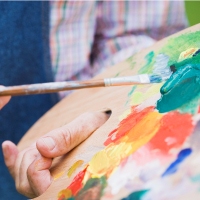 Art therapy is one of the treatments to armed forces veterans with conditions such as post-traumatic stress disorder (PTSD), depression and anxiety. Drawing, sculpting and painting are helping patients manage their symptoms with great success.
Art therapy is one of the treatments to armed forces veterans with conditions such as post-traumatic stress disorder (PTSD), depression and anxiety. Drawing, sculpting and painting are helping patients manage their symptoms with great success.
When a trauma happens, the person will react to get through the experience, but it leaves the trauma unprocessed. A person might then get a sensory memory like a sound, or sight, or smell, that is reminiscent of the trauma and they re-experience it happening again.
‘Blank mind’
Art therapy aims to help people express themselves unconsciously and process the meaning afterwards. Group sessions typically begin with the therapist giving a one or two word brief to inspire creativity before veterans are given a selection of materials for painting, modelling or writing. After 45 minutes of quick work, the group then get together to talk about and describe what they’ve just created.
After their sessions, the veterans are encouraged to develop their initial artwork into fuller, finished pieces to further interpret and explore their feelings.
Invisible wounds:
Although many of the veterans who try the therapy may never have had any interest in art before, there are some servicemen who actively pursue the craft and use it to reflect their experiences.
The Army Arts Society, set up by war artist Linda Kitson after the Falklands War, promotes and supports arts and crafts within the British Army – working with serving military, those who have retired and even their dependants.
‘Angry and frustrated’
Art has been invaluable for 32-year-old Norfolk serviceman, Nick Hendry. Having joined the army when he was 16, he has been posted in countries including Germany, Kosovo and Afghanistan.
After qualifying as a diving supervisor for his regiment’s airborne unit in Portsmouth, he was attacked and left with serious head injuries. In a coma for almost a month, he spent a lengthy time in a rehabilitation unit, suffered from hallucinations and memory loss.
It was while looking through regiment photos that Nick thought he would try his hand at painting. A colleague’s wife suggested he join the Army Arts Society, when he gained a new lease of life.
With lack of self-confidence, he spent about 50 to 70 hours on a picture. The society encouraged Nick to enter its Serving War Artist of the Year competition – which he went on to win for his water colour, Deliberation. Nick struggled trying to justify everything, but as soon as he got hold of a paintbrush it took his mind off some really bad thoughts and focused his mind on one thing.”
Richard Kidgell agrees it’s a good idea to give soldiers the opportunity to process what they are experiencing on a tour of duty. Potentially, it can allow the military to spot the symptoms of PTSD early. For the minority, who will grasp the idea, the benefits for catching those people at an early stage and giving them a chance to vent will be brilliant.

Hi! Do you know if they make any plugins to assist with
Search Engine Optimization? I’m trying to get my blog to rank for some targeted keywords
but I’m not seeing very good success. If you know of any please
share. Thank you! I saw similar article here: Wool product
Can you be more specific about the content of your article? After reading it, I still have some doubts. Hope you can help me. https://accounts.binance.com/tr/register?ref=W0BCQMF1
Hi! Do you know if they make any plugins to help with Search Engine Optimization? I’m trying
to get my blog to rank for some targeted keywords but I’m not seeing very good results.
If you know of any please share. Many thanks!
You can read similar art here: Change your life
I am extremely inspired with your writing abilities as neatly as with the layout for your weblog. Is this a paid subject or did you modify it your self? Anyway keep up the nice high quality writing, it is rare to look a nice blog like this one nowadays. I like sandaretreats.com !
I am really impressed together with your writing abilities and also with the structure on your blog. Is this a paid subject or did you customize it yourself? Either way stay up the excellent high quality writing, it is rare to peer a great blog like this one nowadays. I like sandaretreats.com ! Mine is: Affilionaire.org
I’m really inspired together with your writing talents as well as with the format to your weblog. Is this a paid subject or did you modify it your self? Either way keep up the nice quality writing, it is rare to peer a great blog like this one nowadays. I like sandaretreats.com ! It’s my: Instagram Auto comment